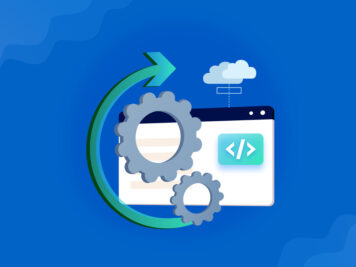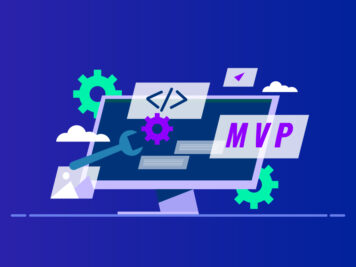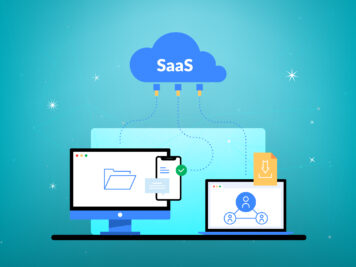If you an early-stage startup founder building your first SaaS product or a scaling SaaS company hitting architectural and hiring ceilings—you’re likely feeling the pressure. Tight funding, aggressive timelines, and the rising complexity of AI-native architectures are reshaping what it takes to ship great software. And in a market projected to surpass $1.2 trillion by 2034, the winners will be those who move faster without breaking things. That’s why more product-led teams are turning to outsourcing SaaS development—not to “offload” work, but to embed partners who can bring:
- Immediate access to AI, cloud, and secure software talent
- Speed without sacrificing technical depth
- Scalable delivery models aligned with product cycles
- A way to focus internal teams on what only they can do
In this article, we’ll walk you through seven signals that it’s time to outsource, break down real risks (and how to mitigate them), and show how the right development partner can accelerate your roadmap without compromising control or quality.
If you’re serious about shipping faster, scaling smarter, and keeping focus on what actually moves the business—you’re in the right place.
Check these 7 signs: Are you facing these challenges while developing your SaaS product?
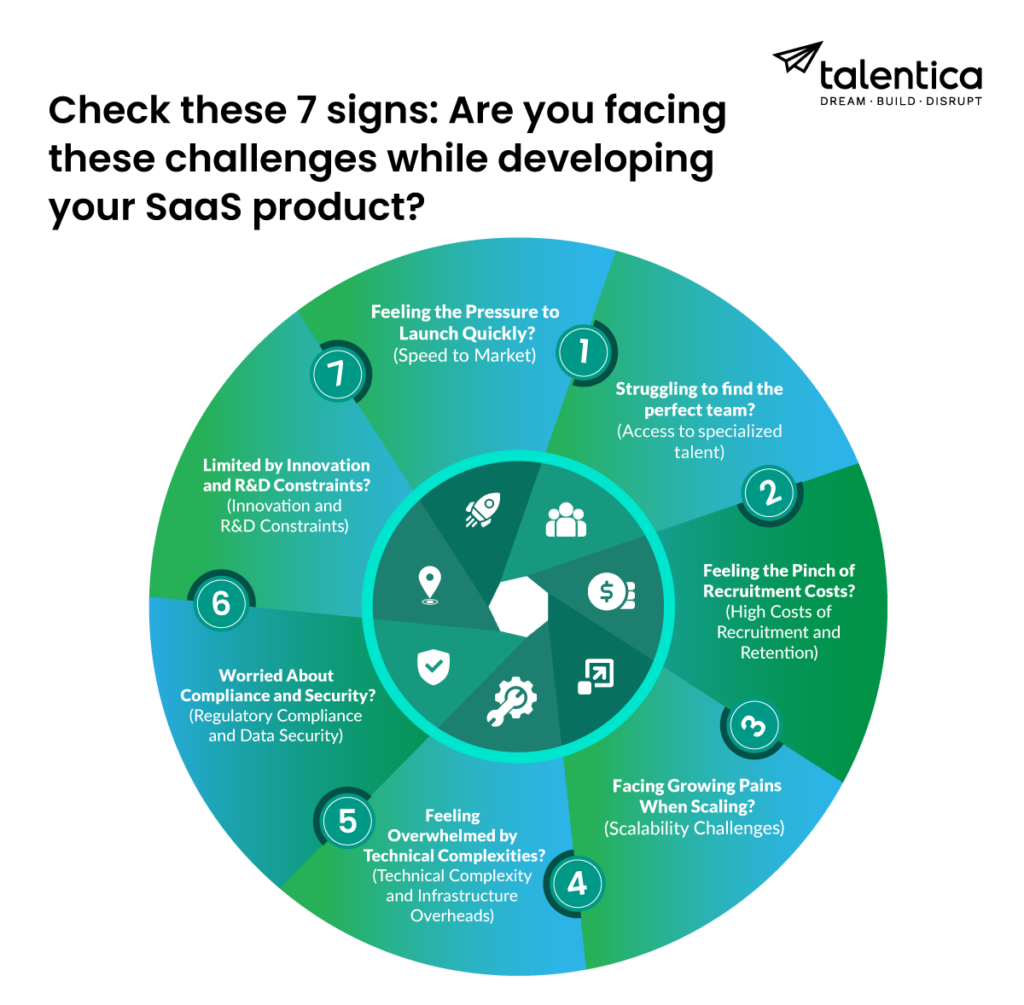
1. Struggling to find the perfect team?
For early-stage SaaS startups, speed is survival. You are racing to validate your MVP, hit product-market fit, and stay ahead of competitors- all while the clock (and your runway) ticks fast.
But building a high-performing product team? That’s where most startups hit friction.
The market for top-tier SaaS and cloud-native talent is tighter than ever. You are not just competing with other startups- you are up against scaled companies or enterprises offering six-figure packages and mature dev cultures. Finding engineers who understand fast-paced, iterative SaaS development isn’t just hard-it’s slow.
And slow kills momentum.
Without the right team i place, development stalls. Sprint drag. Features miss windows. Before you know it, your product blends into a noisy market- losing differentiation, users, and investor confidence.
This is the silent killer of early-stage growth- talent gap that delay your roadmaps and dilute your vision.
The good news? You don’t need to build everything in-house to build something world-class. The right development partner can plug the talent gap fast- giving you access to cloud architects, SaaS engineers, and product-first thinkers who accelerate progress without compromising quality.
You don’t need just “more developers.” You need the right developers- fast. Making the right choice requires careful assessment, and our guide can help..
[Download the Guide – The Startup’s Guide To Onboard Right Product Development Partner]
2. Feeling the Pinch of Recruitment Costs?
Even if you do find great talent, the true cost of hiring them can hit harder than expected. In today’s market, roles in cloud architecture, DevSecOps, and SaaS infrastructure don’t come cheap. The competition for skilled developers is intense- and big tech isn’t shy about using deep pockets to win. For early-stage startups, this has created a talent squeeze: salaries are up, time-to-hire is longer, and retention is an uphill climb.
But the burn doesn’t stop at base pay.
You’re also investing in:
- Benefits and equity package to stay competitive
- Onboarding and training time before engineers are fully productive
- Internal infrastructure (tools, system, support) just to keep the team running
That’s the real money, and it adds fast. And then there’s hidden tax: Time.
Recruitment drains bandwidth from your leadership team. Time spent sourcing candidates, interviewing, negotiating offers, and onboarding is time not spent closing customers, shaping the roadmap, or driving growth. In short, you are paying a premium for talent and sacrificing focus- the one thing you can’t afford to lose in early-stage execution.
That’s why many startups are rethinking how they scale engineering. Instead of going all-in on costly in-house hiring, they are turning to strategic partners who bring pre-vetted, product-ready teams- without the recruitment drag or operational overhead. Because scaling should grow your product- not your payroll complexity.
3. Facing Growing Pains When Scaling?
As your SaaS product gains traction, efficiently scaling operations to meet growing demand presents a new set of hurdles. Scaling isn’t just about throwing more developers at the problem; it involves carefully managing resources and your tech infrastructure to support this growth. This lack of agility can become a major roadblock, often leading to tech debts that might necessitate a full modernization or system migration. Such undertakings require significant work hours and can lead to system downtime, negatively impacting ROI.
Many organizations struggle with this agility, hindering their ability to capitalize on market opportunities or respond effectively to unexpected surges in demand. One of our clients, a world-leading mobile ad platform, faced a similar challenge. They needed to scale rapidly to meet a 1200% yearly growth rate, all while keeping response times under 150 milliseconds and reducing ad servicing costs.
By optimizing their infrastructure, streamlining processes, and leveraging big data for faster processing, we helped them achieve remarkable results. Their platform went from processing 22 million to 8 billion ad requests daily, with a 94% reduction in eCPM costs! They’re now equipped to handle 1800% yearly growth without major architectural changes. For details, See the full success story here!
4. Feeling Overwhelmed by Technical Complexities?
Developing and maintaining a robust SaaS platform demands expertise in a vast array of technologies. You need developers who understand cloud architecture, can seamlessly integrate new technologies, and have the foresight to keep existing systems secure and up to date. Building such a team with the right skillset internally can be a daunting task.
But the challenge goes beyond finding the right people. The tech landscape is constantly evolving with new technologies such as confidential computing, quantum computing, and others getting mainstream attention. Staying ahead of the curve with these technologies is crucial or else your product could become functionally obsolete compared to competitors who prioritize innovation. The challenge might lie in the hidden opportunities you miss because your team lacks the expertise to identify them.
5. Worried About Compliance and Security?
The world of SaaS is heavily regulated, with specific compliance requirements varying across geographic regions. Meeting compliance standards like GDPR and HIPAA requires ongoing vigilance and expertise. Ensuring robust data security measures and privacy standards across various markets is crucial and often requires dedicated expertise and resources.
Failing to adhere to these regulations can result in hefty fines, reputational damage, and even legal repercussions.
Beyond compliance, ensuring robust data security measures and privacy standards across various markets is crucial. This requires dedicated expertise and resources and neglecting it can leave your users’ data vulnerable. Building an internal team with the expertise to stay compliant in a constantly evolving regulatory landscape can be a significant challenge. Additionally, dedicating resources to compliance tasks can divert them away from core development activities.
6. Restricted by Innovation and R&D Constraints?
Limited resources can create a vicious cycle for SaaS companies. Strapped for cash companies can be forced to prioritize immediate development needs over long-term innovation. This focus on keeping users engaged today leaves little room to explore the disruptive ideas that could be their future differentiators.
The constant churn of emerging technologies adds another layer of complexity. Experimenting with every new tool is a resource and time black hole, especially for early-stage startups. Dedicating an entire team to R&D simply isn’t an option. The result? Stagnation. Without the ability to explore cutting-edge features and technologies, a product can quickly become outdated, leading to declining user engagement and ultimately hindering long-term growth.
7. Feeling the Pressure to Launch Quickly?
Are internal constraints delaying your product launches? The ability to launch products swiftly is critical in the competitive SaaS landscape. Delays in development cycles due to internal inefficiencies can hinder your company’s ability to establish a strong market position and achieve timely market penetration.
One of our clients, a leading digital fintech platform, had an amazing opportunity to build and launch a new technology product to capture the market demand. However, a tight deadline and a limited engineering team presented significant challenges. We streamlined their process, filled skill gaps with our expert engineers, and fostered a seamless collaboration to enable a successful launch of their entire product in just 5 months! See the full success story here!
How can outsourcing SAAS development to the right partner help you in the long run?
The challenges we’ve discussed can feel overwhelming, but there’s a powerful solution: partnering with the right team. This trusted partner becomes an extension of your in-house team, providing the expertise and resources needed to overcome these hurdles and achieve long-term success in the competitive SaaS market.
Here’s how an experienced outsourcing partner can help you navigate these complexities and achieve long-term success in the competitive SaaS market:
- Early detection of engineering gaps: Building your team internally means constantly monitoring skill gaps and inefficiencies. Experienced outsourcing partners come equipped with the experience to spot engineering issues early- before they stall your roadmap. They flag architectural risks, performance bottlenecks, or security blind spots before they become costly mistakes
- Invaluable guidance from experienced partners: Many outsourcing firms bring extensive experience from working on hundreds of tech products. This translates into a wealth of knowledge. They can offer invaluable guidance on best practices, market trends, and potential pitfalls, helping you build a product that’s not only technically sound but also aligns perfectly with market demands.
- Smarter cost structures:Hiring full-time engineers means long-term payroll, benefits, and overhead. With outsourcing, you pay for outcomes- not headcount. Scale up or down as your needs change, without long-term commitments weighing down your burn rate.
- Quick access to top talent: You don’t always have time to hire. Need a senior backend engineer next week? A DevOps lead who’s scaled infra for 10M+ users? A QA team to run test automation on your next release? Outsourcing unlocks ready-to-deploy- senior engineers, architects, DevOps, QA- without a 3- month hiring cycle. The right partner can ramp up a product initiative in days, not weeks, giving you speed and agility in hyper-competitive markets.
- Long-term commitment and flexibility: Many outsourcing companies offer the option of a long-term partnership. This provides you with a consistent, dedicated team you can rely on, eliminating the hassles and costs associated with employee turnover and retraining.
- Handling of hiring hassles: Outsourcing frees you from the burden of managing the recruitment and hiring process, which can be a major challenge in today’s competitive tech talent landscape. This allows you and your team to dedicate more time and energy to core business activities like strategic planning, customer engagement, and market expansion.
- Reduction of work cycles: Outsourcing can streamline development processes, reducing the time from conception to deployment by utilizing efficient, established workflows from experienced partners.
- Innovation through diverse perspectives: Working with distributed teamsbrings new thinking, fresh patterns, and product insight you might not get inside a single market. Innovation is easier when you are not stuck in one perspective.
- Focus on core business: Every hour your founding team spends managing dev tickets is an hour not spend on customer acquisition, fundraising, or market strategy. The right partner takes technical execution off your plate, so you can double down on growing the business.
- Access to latest technologies: You don’t need to hire a full AI team or train your engineers in edge deployments. Right outsourcing partner already works with the latest stacks and bring that expertise straight into your product. That means you can experiment, iterate, and integrate new tech- without waiting to catch up.
- Faster time-to-market: SaaS is a race. And speed wins. Outsourcing gives you an on-demand team that can ship, iterate, and release- fast. No delays. No hiring bottlenecks. Just focused execution that helps you outpace competitors.
But there are risks to outsourcing if not done diligently!
Outsourcing SaaS development, while beneficial, comes with its set of challenges and risks. Here’s a look at the potential pitfalls you might encounter and the strategies to keep your project safe and sound:
Communication overheads: Working with teams across time zones and cultures can lead to misunderstandings. This can manifest as missed deadlines, misinterpreted requirements, or features that don’t align with your vision.
Quality and compliance issues: Ensuring top-notch work can be a worry, especially if you haven’t worked with the outsourcing partner before. You might receive code that’s buggy, doesn’t meet security standards, or doesn’t function as intended.
Loss of control over the development process: Handing over critical development tasks to an external team can feel risky due to a lack of direct oversight on day-to-day decisions. This can lead to concerns about project alignment, potential delays, or communication gaps.
Dependency on external teams: Relying heavily on one outsourcing partner can be problematic. If the partnership sours due to unforeseen circumstances, like political instability, economic downturns, or business failures of the vendor, your project could be jeopardized.
Strategies for successful SaaS outsourcing
Now that we’ve identified the potential pitfalls, let’s explore the strategies that will help you overcome them:
Set up communication that doesn’t waste everyone’s time
Communication is the first thing that breaks when you outsource- especially across time zones. The solution is not more Zoom calls. It’s clarity.
You need:
- Defined roles: Who owns what? Who is the decision-maker? Who pushes back?
- Two channels: Synchronous (quick decisions), asynchronous (deep thinking and updates).
- One rule: If you are relying on real-time calls to unblock basic work, something is broken.
The teams that win don’t just “stay in touch”, they design how they communicate, and it shows in their speed.
Choose partners like you are hiring a key executive
Too many teams treat vendor selection like a procurement task. It’s not. This team is going to own your roadmap. Treat it like hiring a VP.
That means:
- Ask for specific case studies- projects shipped, results achieved; timelines hit.
- Look under the hood- do a small technical spike or architecture review before signing anything.
- Pay attention to how they handle tough questions- that’s where most vendors show their true maturity.
If it feels like a red flag now, it becomes a full-on blocker three months in.
Don’t just say “high quality” – define it
“High quality” is meanigless unless you define it. What counts as done? What does clean code actually mean to you?
Set your bar early:
- What’s the definition of done?
- What is the minimum test coverage?
- How do we handle bugs, tech debt, and rollbacks?
Good teams don’t get defensive about quality. They want the target clearly drawn so thay can hit it.
Make the contract a working document, not just legal filler
Here’s the trap: you sign the MSA, scope the project, and assume the contract’s done its job. But if you want execution clarity, your contract needs to:
- Define SLAs that match your internal expectations.
- Spell out delivery formats, review timelines, and escalation paths.
- Include compliance clauses (especially if Gen AI or sensitive data is involved) , IP, and data clauses that don’t just protect you- but make execution cleaner.
- Fallback plans for resource shifts, delays, or priority changes.
The best partnerships are built on contracts that clarify how you will work together, not just protect you when things go wrong.
Review performance frequently, not reactively
High–functioning teams adopt continuous performance feedback loops. They don’t wait for milestones to evaluate outcomes.
- Implement regular (biweekly or monthly) reviews to assess progress against KPIs, raise blockers early, and adjust priorities dynamically.
This cadence builds trust, reveals systemic issues before they become disruptive, and creates alignment across teams- even when they are distributed globally.
By understanding the risks and implementing these strategies, you can make outsourcing a successful endeavor for your SaaS development in 2025.
A cost comparison of different outsourcing strategies!
Choosing the right outsourcing strategy hinges on your project’s specific needs. Here’s a breakdown of the cost implications for different approaches:
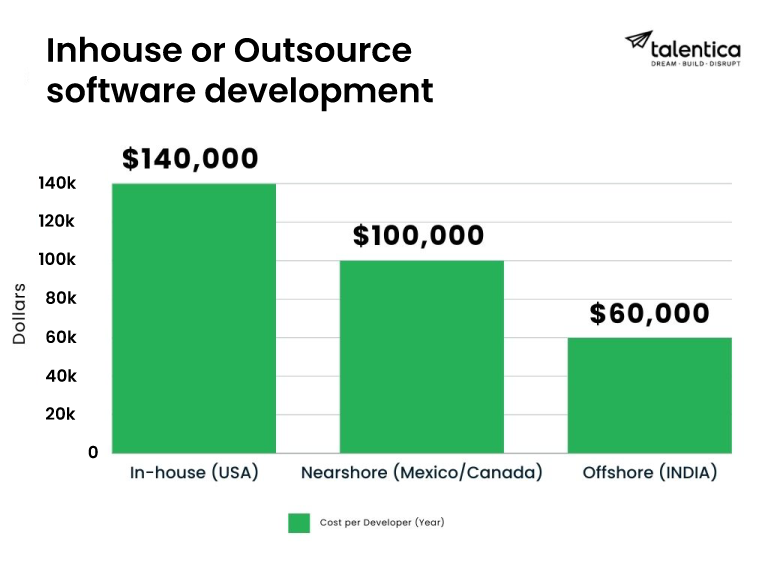
| Feature | In-House (USA) | Nearshore (Mexico/Canada) | Offshore (India) |
| Control & Alignment | Highest | High | Moderate |
| Market Understanding | Deep | Moderate | Limited |
| IP Protection | Stringent | Good | Moderate |
| Cost per Developer (Year) | $140,000 | $100,000 | $60,000 |
| Communication Challenges | Lowest | Low | Moderate |
| Time Zone Alignment | None | Partial | Significant |
| Scalability | Limited | Moderate | High |
| Hiring & Management | High Effort | Moderate Effort | Lower Effort |
| Project Suitability | Complex Projects | All Projects | Budget-Conscious Projects |
| Overall Cost Advantage | Least | Moderate | Most |
| Development Speed | Moderate | Moderate-High | Potentially High (Time Zone Advantage) |
| Technical Expertise | Access to Top Talent Pool | Access to Skilled Talent Pool | Access to Large Talent Pool (Varied Expertise) |
| Team Turnover | Potentially Lower | Moderate | Potentially Higher |
Finding your perfect fit
The ideal outsourcing strategy depends on your project’s needs. If tight control and market understanding are crucial, in-house development might be the best choice. Needing a balance between cost and communication makes nearshore a good option. But for budget-conscious projects with a global perspective, offshore development can be a game-changer. Remember, the best fit is the one that empowers your SaaS dreams!
How SaaS development is changing in 2025
The way we build SaaS is shifting- again. But this time, it’s not about which JS framework is hottest or whether you’re using microservices. This time, the entire SaaS stack – from architecture to monetization – is being rethought because of AI, buyer maturity, and the rising complexity of scale.
Here’s what changing in 2025 (and what you should do about it):
AI –Native SaaS is the new standard
In 2024, SaaS teams bolted GenAI onto their products. In 2025, that approach looks like a hack. Today’s smartest SaaS companies are building AI-native platforms—where copilots, agents, and adaptive experiences are part of the foundation, not the frosting.
According to PwC, 79% of enterprises are already integrating AI agents into ops, and 66% are seeing measurable productivity gains.
What this means for you:
- Build features that learn, not just respond.
- Shift UX from “click to configure” to “tell me what to do.”
- Architect for data loops, model governance, and AI-specific observability from day one.
Ready to go deeper?
We recently hosted a webinar- “Will Agentic AI Replace or Reinvent SaaS?” – to unpack exactly this shift.
In it, our Senior Data Scientist, Alakh Sharma and our Software Architect, Ritesh Agarwal has break down how agentic AI is reshaping SaaS – from product strategy to system design. We covered real-word architectures, team structure changes, and technical trade-offs founders and engineering leaders should be thinking about now.
Watch the webinar to see what this evolution means for your roadmap:
Security in SaaS outsourcing
In 2025, the SaaS security conversation has shifted from “how secure is your product” to “how secure is your entire SaaS ecosystem.” With GenAI integration, non-human identities, and SaaS –to- SaaS connections expanding rapidly, the real risk isn’t the core app- it’s everything around it.
The 2025 Cloud Security Alliance (CSA) report makes it clear:
- 86% of organizations now rank SaaS security as a high priority, with 76% increasing their budgets.
- 63% of organizations report external data oversharing with 3rd party tools, often through unsanctioned integrations.
- 55% say employees adopt SaaS tools without any involvement from security teams.
- IAM (Identity and access management) remains a weak link, with 58% struggling to enforce appropriate privileges.
What this means for you:
- Run deep vendor assessments: Don’t stop at SOC 2 or ISO 27001 logos. Ask how often security controls are tested, how non-human identities are monitored, and whether the vendor uses continuous compliance tools.
- Monitor Saas-to-SaaS interactions: Many organizations underestimate the risk of unmonitored integrations. Security needs to extend beyond your own platform to cover every connection, token, and external API.
- Adopt Secure-by Design development practices: Zero-trust architecture, role-based access controls (RBAC), and full encryption (both in transit and at rest) should be foundational – not added later. As SaaS environments become more distributed and integration-heavy, securiy needs to be proactively engineered into every component.
Ratnesh Singh Parihar, our Principal Architect, outlines this direction clearly in an article “” Best practices for AI-Based Security for 2025“” published in Data Science Central:
“” As cyber threats evolve, ZTA’s approach—assuming no entity, internal or external, can be inherently trusted—will set the standard for secure software systems across industries. By enforcing strict identity verification, implementing least privilege access, and using continuous monitoring and micro-segmentation, organizations will create highly resilient systems capable of withstanding sophisticated attacks. “”

Compliance in SaaS outsourcing
The IRS’s 2025 regulations have redefined how SaaS income is classified and sourced. Under Reg. §1.861-19, all cloud-based offerings- including SaaS- are now treated as services, not licenses. This shift has direct implications for tax strategy, cross-border operations, and vendor contracts.
What this means for you:
- Contracts must align with service-based treatment. Legacy licensing templates may misclassify transactions, creating regulatory risk. Legal teams should rework language to clearly reflect service-based delivery, especially in cross-border agreements.
- Outsourced development needs tighter documentation. Where the code is written, who owns the output, and how that output supports service delivery must now be tracked and classified correctly.
- Prepare for continuous audit-readiness. IRS sourcing rules now require SaaS companies to prove where income is earned and how it’s used. This overlaps with GDPR, HIPAA, SOC-2 – but also introduces new data reporting needs specific to the USA. Tax laws.
Talent strategy is becoming product strategy
According to ICONIQ’s 2025 state of AI: The Builders playbook, the biggest SaaS differentiator isn’t who has the most advanced model- it is who can build, ship, and scale AI- native products fast.
47% of AI-first companies have already reached scale and market fit, compared to just 13% of AI-enabled teams still retrofitting existing platforms.
What they are building: agentic workflows and vertical AI applications.
How they are building: with multi-model architectures and AI –focused products pods.
What this means for you:
- Speed to value> model perfection.
- Build for learning, adaptation, and user outcomes- not just feature parity.
- AI- native success is more about product execution than algorithmic complexity.
That’s why companies serious about building AI-native SaaS are turning to engineers’ partners who don’t just understand AI-but know how to build products with it. For over 20 years, Talentica has helped tech-first startups and enterprises turn cutting-edge ideas into market-ready software. What sets us apart? A product-first mindset, deep expertise in AI/ML, and a track record of building with speed, precision, and scale.
Our cross-functional teams are built to solve modern product challenges: from shipping multi-model architectures to ensuring model observability, security, and compliance from day one. If you are ready to move from experimentation to execution, we can help you build a product your users will love.
Talk to us about your next AI-native SaaS product.
Conclusion
Outsourcing isn’t a shortcut. Done right; it’s a multiplier.
It lets you close hiring gaps without wasting six months on recruitment. It gives you access to engineers who’ve solved the problems you’re about to hit. It keeps your internal team focused on the roadmap, not buried in technical debt or compliance headaches.
But it only works if you choose a partner who builds like you would—product-first, execution-focused, and aligned on outcomes.
If you’re ready to move fast without breaking what matters, let’s talk.
